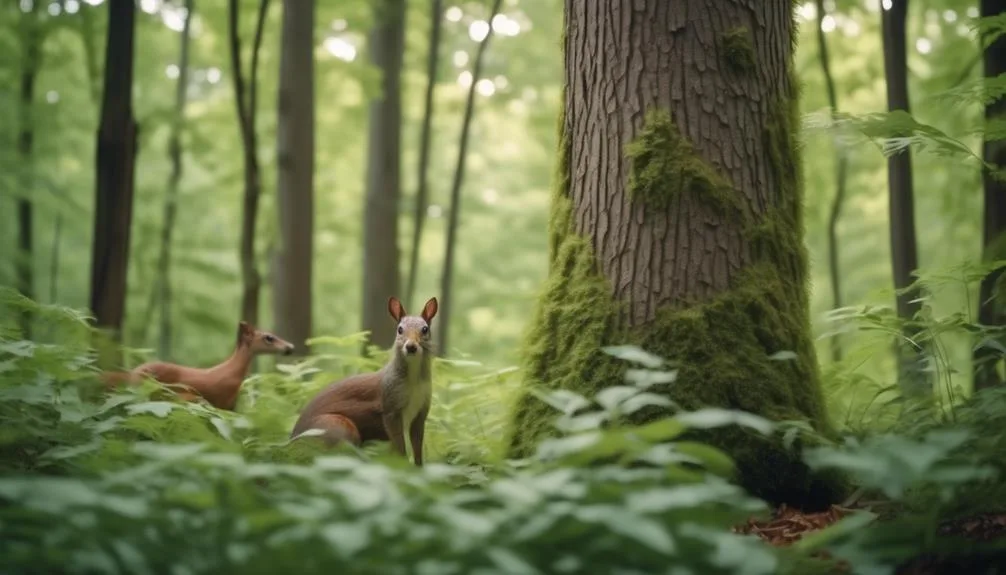Hickory trees are more than just shade and nuts – they're key to a thriving wildlife habitat. These majestic trees provide food and shelter, attracting diverse wildlife.
But how exactly do they contribute to biodiversity, and how can you maximize their potential as a wildlife habitat?
Let's explore the world of hickory trees and the wildlife they support.
Benefits of Hickory Trees for Wildlife
Hickory trees provide essential food and shelter for a wide variety of wildlife, making them an invaluable asset in creating a thriving habitat. Several hickory tree species, such as the shagbark hickory and the pignut hickory, produce nuts that are a crucial food source for many animals. Squirrels, deer, wild turkeys, and various bird species rely on hickory nuts for sustenance.
Additionally, the dense foliage and sturdy branches of hickory trees offer ideal nesting sites for numerous bird species, contributing to wildlife conservation efforts. The presence of hickory trees in an area not only supports existing wildlife populations but also attracts and sustains diverse species, promoting a healthy and balanced ecosystem.
Selecting the Right Location for Hickory Trees
After recognizing the invaluable role hickory trees play in supporting wildlife, it's essential to carefully consider the location when planning to introduce these trees into a new habitat. Choosing the right species of hickory tree is crucial for the success of your wildlife habitat. Select species that are native to your region and well-suited to the local climate and soil conditions.
When selecting a location, prioritize areas with well-draining soil to prevent waterlogging, as hickory trees prefer moist but well-drained soil. Additionally, consider soil preparation to ensure the hickory trees have the best start. Conduct a soil test to determine the pH and nutrient levels, and amend the soil as needed to create an optimal growing environment.
Planting and Caring for Hickory Trees
When preparing to plant and care for hickory trees, it's crucial to consider the specific needs of these trees and the surrounding environment. Start by selecting a well-drained location with deep, fertile soil. Before planting, ensure the soil is well-prepared by loosening it to a depth of at least 12 inches and incorporating organic matter.
After planting, provide regular watering, especially during dry periods, to help the young trees establish their root systems. Once established, hickory trees generally require minimal watering, as they're adapted to survive in a variety of soil conditions.
Additionally, periodic pruning is essential to remove dead or diseased branches and maintain a strong tree structure. Keep an eye out for common pests such as hickory bark beetles and apply appropriate pest control measures if necessary.
Wildlife Supported by Hickory Trees
Supporting a diverse array of wildlife, hickory trees offer valuable resources and habitat for various species. Hickory trees provide an ideal environment for bird nesting and squirrel foraging. The trees offer sturdy branches and dense foliage, providing safe nesting sites for a variety of bird species. Additionally, hickory nuts are a staple food for squirrels, supporting their foraging activities. Here's a table summarizing the wildlife supported by hickory trees:
| Wildlife Supported | Activities Supported |
|---|---|
| Birds | Nesting |
| Squirrels | Foraging |
Hickory trees play a crucial role in supporting the ecosystem by providing food and shelter for a range of wildlife. By planting hickory trees, you can actively contribute to the preservation of these species in your local environment.
Maintaining a Hickory Tree Wildlife Habitat
To maintain a thriving hickory tree wildlife habitat, you can implement specific practices that sustain the ecosystem, ensuring continued support for the diverse array of wildlife they attract and nurture.
Regularly monitoring the health of your hickory trees is crucial for habitat preservation. Trim any damaged or diseased branches to maintain a robust and safe environment for the wildlife.
Additionally, consider planting a variety of native plants around the hickory trees to attract species such as squirrels, deer, and various bird species. Providing fresh water sources, like birdbaths or small ponds, can further enhance the habitat and attract a broader range of wildlife.
Conclusion
Ready to create a thriving hickory tree wildlife habitat in your own backyard? With the right location and maintenance, you can support a variety of wildlife, making a positive impact on your local ecosystem.
So grab your gardening gloves and get started on this rewarding journey of nurturing nature.

My interest in trees started when I first saw the giant sequoias in Yosemite.
I was a teenager then, and I remember thinking, “I need to learn more about this.”
That moment stuck with me.
A few years later, I went on to study forestry at Michigan Tech.
Since graduating, I’ve worked in a mix of hands-on tree care and community education.
I’ve spent over ten years helping people understand how to plant, maintain, and protect the trees in their neighborhoods.
I don’t see trees as just part of the landscape.
They are living things that make a real difference in our daily lives.
